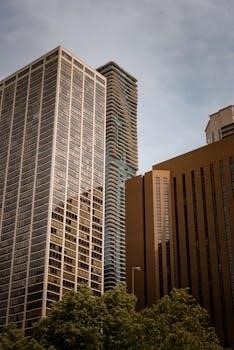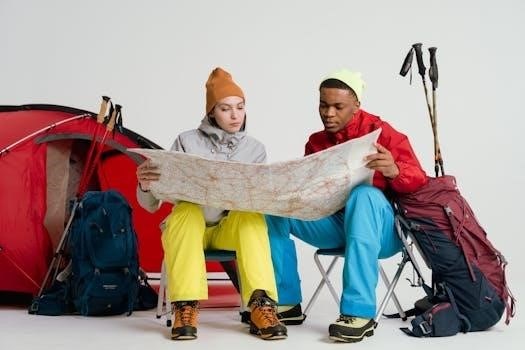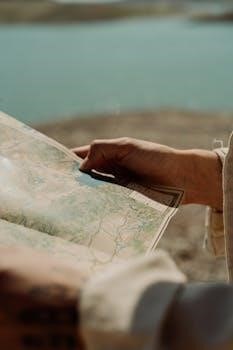The Tucson Loop⁚ An Overview
The Tucson Loop, also known as The Huckleberry Loop, is a 137-mile network of shared-use paths in metropolitan Tucson, Arizona․ It is an open-space art gallery, featuring art and sculptures, and connects various communities, parks, and historical sites․
What is the Tucson Loop?
The Tucson Loop, often referred to as the Chuck Huckelberry Loop, is a comprehensive network of shared-use paths designed for cyclists, pedestrians, and equestrians․ This expansive system weaves through the Tucson metropolitan area, connecting various communities, parks, and natural spaces․ It is essentially a 137-mile open-space art gallery, showcasing numerous public art pieces and sculptures․ The Loop is more than just a trail; it’s a recreational and transportation corridor, offering a unique way to explore the beauty of the Sonoran Desert․ Maintained by Pima County, the Loop provides a safe and accessible environment for outdoor activities, promoting health and wellness․ Furthermore, it serves as a vital link between different parts of the city, fostering community engagement and exploration․

The Loop’s Extent and Connectivity
The Tucson Loop spans 137 miles, connecting Tucson, Marana, Oro Valley, and South Tucson․ It is a network of paved paths and bike lanes, facilitated by Pima County’s partnerships with various jurisdictions․
Length and Geographic Coverage
The Tucson Loop boasts an impressive length of approximately 137 miles, offering extensive coverage throughout the metropolitan area․ This expansive network of paved paths and bike lanes meanders through diverse landscapes, connecting various communities and natural areas․ The Loop’s geographic reach extends through unincorporated Pima County, as well as the incorporated areas of Marana, Oro Valley, Tucson, and South Tucson․ This widespread coverage ensures that residents and visitors alike can easily access and enjoy the trail system․ The loop is not just a single path but rather a network of interconnected trails, offering a variety of routes and experiences for users of all types․ Its design allows for exploration of the greater Tucson area, linking urban environments with the surrounding Sonoran Desert beauty․ This extensive coverage makes it a significant recreational and transportation asset for the region․
Jurisdictional Partnerships
The successful development and maintenance of the Tucson Loop is a testament to the strong jurisdictional partnerships in the region․ Pima County plays a central role in maintaining the shared-use paths, but the loop’s connectivity is greatly enhanced through cooperative agreements with various municipalities․ These partnerships include the cities of Marana, Oro Valley, Tucson, and South Tucson, all of whom contribute to the overall success of the trail network․ This collaborative approach ensures that the Loop seamlessly integrates across different jurisdictions, creating a unified and easily accessible amenity for the entire community․ The connections between these areas are a result of Pima County’s strategic partnerships, fostering a cohesive trail experience․ This collaborative effort demonstrates how intergovernmental cooperation can lead to the creation of valuable public resources, benefiting residents and visitors alike while promoting regional connectivity․

Features of the Tucson Loop
The Tucson Loop boasts a variety of features, including public art installations and sculptures․ It also provides interactive mapping and resources, making it easy to navigate and explore the trail system․
Art and Sculptures Along the Trail
The Tucson Loop is more than just a trail; it’s a 137-mile open-air art gallery showcasing incredible pieces from talented artists․ As you traverse the paths, you’ll discover a diverse array of public art and sculptures, adding an element of surprise and visual delight to your journey․ The art along the Loop provides a unique way to engage with the local culture and environment․ You can use the provided maps, like a treasure map, to locate specific art installations, creating a fun and engaging experience․ The El Tour de Tucson Loop Art tour is a great way to explore the art, planning your trip around your favorite pieces․ The Loop truly combines outdoor recreation with an appreciation for art, making it a rich and rewarding experience for all․ Many of the art installations are specifically placed to complement the natural beauty of the Sonoran Desert․
Interactive Mapping and Resources
Navigating the extensive Tucson Loop is made easy with a range of interactive mapping tools and resources․ The official website, TucsonLoop․org, provides access to detailed maps, allowing you to pinpoint specific locations, including art installations, parks, and essential amenities like restrooms and water stops․ An interactive map, courtesy of Pima County, is available online for the entire Tucson/Huckleberry Loop, or you can select specific sections to explore․ These digital maps often feature a legend that lets you mark points of interest, making your journey convenient and tailored to your preferences․ These resources are incredibly beneficial for both casual users and those planning more extensive trips, providing real-time information and enhancing your experience on the Loop․ The interactive maps are also frequently updated to reflect any changes or additions to the trail network․

The Loop’s Purpose and Use
The Tucson Loop is designed as a network of shared-use paths for cyclists, pedestrians, and equestrians․ It promotes active lifestyles and provides a safe, accessible space for recreation and transportation․
Shared-Use Paths
The Tucson Loop is meticulously designed as a network of shared-use paths, catering to a diverse range of users including cyclists, pedestrians, and equestrians․ This multi-modal approach ensures that the paths are accessible and enjoyable for all, fostering a sense of community and promoting outdoor activity․ The paved surfaces are well-maintained, making them suitable for various types of wheeled transportation, from bicycles to strollers, and also comfortable for walking and jogging․ The paths are wide enough to accommodate multiple users simultaneously, minimizing conflicts and creating a safe and pleasant experience for everyone․ The Loop’s shared-use philosophy encourages people of all ages and abilities to engage with the outdoors and enjoy the beautiful landscape of Tucson and its surroundings․ Additionally, the shared nature of the paths promotes a sense of community and provides opportunities for social interaction among users, enhancing the overall experience of exploring the Loop․
Accessibility and Activities
The Tucson Loop prioritizes accessibility, making it inclusive for individuals of all abilities․ The paved paths ensure smooth navigation for wheelchairs and other mobility devices, enabling everyone to enjoy the outdoors․ Beyond accessibility, the Loop offers a wide range of activities․ Cyclists can enjoy long rides, while pedestrians can stroll at their leisure․ The trail also caters to equestrians, allowing for horseback riding in certain sections․ The Loop’s connections to various parks and historical sites provide opportunities for exploration and learning․ Furthermore, the trail is dotted with amenities such as water stops, restrooms, and restaurants, adding convenience for users․ The Loop encourages a healthy lifestyle by providing spaces for recreation and exercise, supporting both physical and mental well-being for residents and visitors alike․ Its versatility makes it a vibrant hub for diverse activities, fostering an active and engaged community․

Accessing the Tucson Loop
The Tucson Loop is easily accessible through interactive maps and downloadable PDF versions․ These resources help users plan their routes, find amenities, and explore the trail’s many features along the way․
Interactive Map Availability
An interactive map of the Tucson Loop is readily available online, offering users a dynamic way to explore the extensive trail system․ This digital resource, hosted by Pima County, allows users to pinpoint specific locations, including restaurants, bathrooms, and water stops․ The interactive map provides a detailed view of the entire Tucson/Huckleberry Loop and allows users to select specific sections of the trail․ It’s a valuable tool for planning trips, whether you’re cycling, walking, or riding a horse․ The map also highlights public art installations along the path, enabling users to create custom art tours․ With its user-friendly interface, the interactive map is a great resource for all users․ Using the interactive map, you can easily locate places of interest and plan your next adventure on the loop․ The map is available courtesy of Pima County․
PDF Map Download Options
For those who prefer a hard copy or offline access, the Tucson Loop offers PDF map download options․ These downloadable maps provide a comprehensive overview of the entire trail network, including key landmarks and points of interest․ Users can easily access and save these PDF files to their devices for convenient use․ The PDF maps often include details about the art installations along the loop, allowing users to plan their exploration around their favorite pieces․ These maps also include information on the various connections to parks and other trails in the Tucson area․ The PDF map provides a static view of the loop, which can be very useful for planning a trip without relying on internet access․ These downloads are a valuable resource․ The maps are usually available on the official Friends of The Tucson Loop website and other related sites․ Download a map today and explore!

